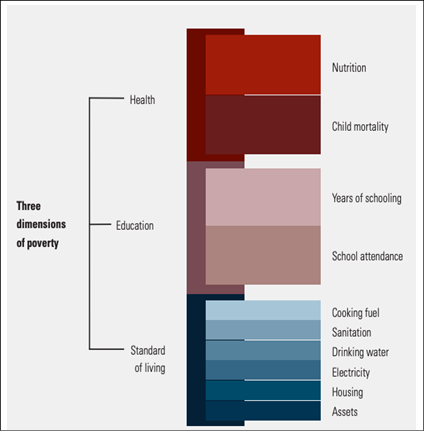APPROACH AND STRUCTURE
-
- Introduce with SDG 1.
- Briefly explain the meaning of given statement.
- Explain about MPI and how it is calculated.
- Analyse the findings of MPI report 2020.
- Conclusion – Covid context
INTRODUCTION: Sustainable Development Goal (SDG) 1 aims to end poverty in all its forms everywhere. Although previously defined only in monetary terms, poverty is now understood to include the lived reality of people’s experiences and the multiple deprivations they face.

Income may not be manifestation of true measurement of poverty. The process or criteria to decide the poverty levels should consider various dimensions of poverty such as incidence and intensity of poverty.UN Multidimensional Poverty Index considers this aspect and arrive at multidimension poverty counts.
The MPI is the product of the incidence of multidimensional poverty (the percentage of people who are multidimensionally poor—also referred to as the headcount ratio or the multidimensional poverty rate, H) and the intensity of multidimensional poverty (the average share of indicators in which poor people are deprived, A): MPI = H × A. It is therefore sensitive to changes in both components. To be multidimensionally poor, a person must be deprived in at least a third of the weighted indicators.The MPI ranges from 0 to 1, and higher values imply higher poverty.
The global MPI examines each person’s deprivations across 10 indicators in three equally weighted dimensions—health, education and standard of living and offers a high-resolution lens to identify both who is poor and how they are poor.
Analysis of findings of the report:
-
- Sixty-five countries, home to 96 percent of the population of the 75 countries studied, significantly reduced multidimensional poverty.Overall, 62 of the 65 countries with a significant reduction in MPI value had a significant reduction in the incidence of poverty.
- Of the 65 countries that reduced their MPIT value, 50 also reduced the number of people living in poverty. The largest reduction was in India, where approximately 273 million people moved out of multidimensional poverty over 10 years.
- in 14 Sub-Saharan African countries that reduced their MPI value, the number of poor people rose because of rapid population growth. These findings show the impact of population growth on the number of multidimensionally poor people.
- Of the 1.3 billion multidimensionally poor people, 82.3 percent are deprived in at least five indicators simultaneously.
- 71 percent of the 5.9 billion people covered experience at least one deprivation; however, the average number of deprivations they experience is five.
- There is a negative, moderate but statistically significant correlation between the incidence of multidimensional poverty and the coverage of three doses of the diphtheria, tetanus and pertussis (DTP3) vaccine.
- 2 percent of multidimensionally poor people live in rural areas, where they are more vulnerable to environmental shocks.
- Deprivation in access to clean cooking fuel persists worldwide: 20.4 percent of people in the developing countries covered by the MPI are multidimensionally poor and lack access to clean cooking fuel.
- There is a strong positive association between employment in agriculture and multidimensional poverty, particularly in Sub-Saharan Africa. Agricultural employment may not help reduce poverty in these countries without additional pro-poor policy intervention.
- Before the pandemic 47 countries were on to halve multidimensional poverty by 2030 (SDG 1). But the current crisis has jeopardised the advancement. The report simulates possible impacts of COVID-19 on multidimensional poverty, finding that, if unaddressed, progress across 70 developing countries could be set back 3–10 years.
CONCLUSION:
Significant progress in poverty reduction has been made by some countries but decisive action is needed to sustain progress and ensure no one is left behind. Past success stories on how to tackle the many ways people experience poverty in their daily lives, can show how to build back better and improve the lives of millions Covid-19 is the latest crisis to hit the globe, and climate change all but guarantees more will follow soon.
Spread the Word
